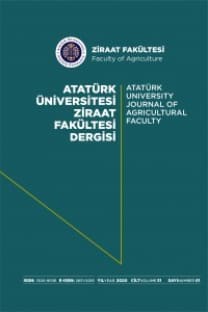ERZURUM EKOLOJİK ŞARTLARINDA YETİŞTİRİLEN BAZI YERLİ VE YABANCI ASPİR (Carthamus tinctorius L.) ÇEŞİTLERİNİN FENOLOJİK VE MORFOLOJİK KARAKTERLERİ İLE VERİMLERİ VE TOHUM ÖZELLİKLERİ ÜZERİNDE BİR ARAŞTIRMA
ÖZETBu çalışma, yerli ve yabancı yirmi aspir (Cartbamus tinctorius L.)çeşidinin fenolojik ve morfolojik özelliklerini, Erzurum ekolojisineadapte olabilme 'potansiyellerini ve bunlar içerisinde erkenci,verimi ve yağ muhtevası yüksek olan çeşitleri tesbit ederek bitkiselyağ ham madde kaynaklarının genişlemesine yardımcı olabilmekiçin 1969 ve 1970 yıllarında Erzurum ovasında Atatürk OniversitesiZiraat Fakültesi Araştırma Enstitüsü arazisi içerisinde yapılmıştır.Bölgeye uygun bir yağ bitkisi olarak aspir üzerinde b~ denemeyegirişilirken bir çok araştırmacının belirtriği gibi bu bitkininhububat bölgelerinde başarı ile yetiştirildiği dikkate alınmıştır.Bitkilerin çimlenme ve ilk büyümeleri üzerinde önemli etkisibulunan Nisan ayı yağışlarınin 1970 yılmda çok düşük (8.8 mm.)olması, bu yılda alınan sonuçların 1969 yılındakine oranla düşük olmasınasebep olmuştur. Bu sonucun alınmasında, 1969 yılındaki denemenin1970 yılı denemesinden bitki besin elementleri bakımından daha zenginbir toprağa teşadüf etmiş olmasının da etkisi bulunmaktadır.ON YIELD AND PHENOLOGICAL, MORPHOLOGICAL AND SEED CHARACTERISTICS OF SOME NATIVE AND FOREIGN VARIETIES OF SAFFLOWER (Carthamus tinetorius L.) UNDERERZURUM ECOLOGICAL CONDlTIONSThis study was conducted to determinesome of the morphologicaland phenological charaeteristics of 20samower (Carthamus tinctorius L.)varieties, during the years of 1969and 1970, in the irr{gated area of no..4 well at the Experiment Station ofAgiİcultural College of Atatürk Universityin Erzurum, Turkey: EvaIuationwere also made to find the varietieswhich grow early, high in seed yieldand oil content and adaptable to theecologicaI conditıons of Erzurum.The experimentaı area soil waspoor in organic matter and lime, mediumand poor in available phosphorus, richin avaİlable potash. The soi1 was siltyloamİn texture and has a slightlyalcaline reaction of pH 7.7.The experiment was randomi7.edbloek design with' 4 repocations.A uniform rate of 3.0 kg. N/da., 4.5kg. P:z05/da. were applied to all experimenta!plots, before planting. Thesamower varieties were obtained fromEskişehir Plant Breeding and ExperimentStation. Plantings were madeon May 16, 1969 and May 15, 1970.The distanee with in and between therows were 20 cm. and 40 cm. respectively.Haıvestins were made with sıckle atOctober 8, in 1969 and 1970.110There were signifieant differanceamong the varieties in phenologiealcharacters. According to these observations,6 varieties (variety numbers1, 2, 6, 9, 19 and 20) were deteıminedas .early and 4 varieties (5, .16, 17 andand 18) as iate. As the earliest variety,no. 6 had a vegetation period of 120133days. Some of the varieties couldnot reach the maturity, because oftheİr needs for a longer growing season.Significant differances were. observedamong the varieties in the experimentsin the characters (plant height,height of the first branch, number ofbranches and leaves per plant, total leafarea per plant, leaf size, number \offiower and seeds per head, physicaland chemical characteristics ~f the seedand yield) studied. The highest seedyield was obtained from no. 6 varietywith 208.5 klg./da. The varieties no.16, 20, 1, 9 and" 8 fol1ow~d it with130.4, 126.8, 116.6, 111.6 'and J09.5kg. ıda., respectively.The highest oil content in seedwas obtained from the no. 2 variety,with 26.750 %' The varieties'no. 1. and6followedit with 26.57~ % and 26.156%respeetively. The highest oil' yieldper decar -54.7 kg.- was' obtained fromthe variety no. 6. The varieties no.1 and 20 which had the oil yield of31.S kg./da., and 26.3 kg./da., tookplace after no. 6. variety.There were signifİeant pozitivecarrelations between seed yield andnumbl:'r of heads per plant, 1000 seed~. weight and oil content of seed, andnegative correlations between seedyield and hull content of seed, totalleaf area per plant, number of seedsper head, and hull content of seed.The oil content was significandyand negatively correlated with plantheight; total leaf area peı plant, numberof seeds per head, and hull contentof seed. Oil content and hull contentof seed was significandy carrrelated.Oil yidd per decar was ignificantlyand negatevily correlated with plantheight, leaf size and hull content ofseed. On the other hand, oil yield perdecar was significantly and positivelycorrelated with number of head perplant, oil content of seed and seed yield.According to the resuıts of theseexperiments; variety no. 6 (Eskişehir,5-62) was the best among the 20 varietiesin terms of earliness, oil content ofseed, and seed yield under the ecologicalconclitions of Erzurum. This spiny varietywas foııowed by the variety no. i(Eskişehir, 5-54; A.B.D., BC-7), interms of oil yield per decar. The varietyno. 20 (Eskişehir, 5-12S) which hada high seed yield and a high oil contentof seed, took the first place among thespinless ones. These 3 varieties couldbe recommanded for the area.In tenns of seed yıeld the varietyno.. i 6 (Eskişehir, 5- 124) took thesecond place after no. 6. Despite thefact that it had a lower seed oil content,in the case earlier plantings, itcan be considered as a recommandablespinless variety for Erzurum. In teıIDSof oil yield vaıiety no. 19 (Eskişehir,5-127) cou1d be recommanded heforeno. 16.
Anahtar Kelimeler:
-
- ISSN: 1300-9036
- Yayın Aralığı: Yılda 3 Sayı
- Yayıncı: AVES Yayıncılık
Sayıdaki Diğer Makaleler
YABANCIOT TOHUMLARININ YAŞAMA MÜDDETLERİ
VARYANS ANALİZİNİN FARAZİYELERİ VE BUNLARIN BOZULMASıNDAN DOĞAN DURUMLAR
J.h. STALLİNGS, Hayati ÇELEBİ (ÇEV.)
Enver ESENDAL, Fahrettin TOSUN
SABİT SU SEVİYELİ İNFİLTROMETRE
Muharrem GÜLERYÜZ, Lütfi ÜLKÜMEN
